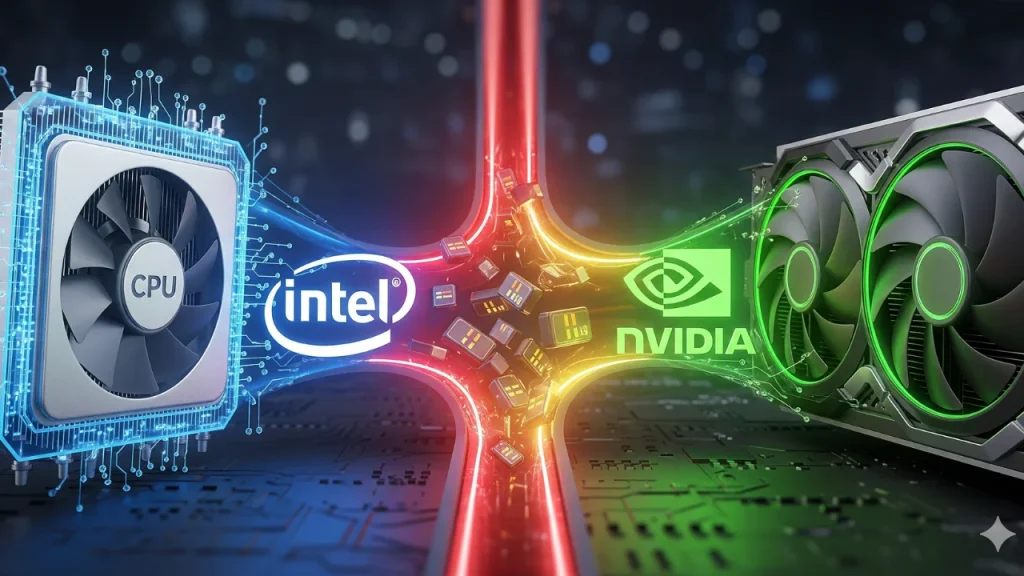Introduction
PC performance has hit a wall. For decades, the CPU and GPU have been two separate components. Data travels back and forth across the motherboard. This back-and-forth creates latency, wastes energy, and slows workloads.
Intel is now building system-on-chips (SoCs) with Nvidia RTX GPU chiplets integrated directly with its x86 CPUs. In simple words, the CPU and GPU will share the same piece of silicon. This could mark the most dramatic shift in PC hardware since multi-core processors arrived.
This article explains how Intel’s new SoC design works, why it matters, and how it could redefine everything from gaming to AI. It also offers insight for founders and decision-makers, including those hiring a fractional CTO, about what this trend means for their tech strategy.
The Traditional Bottleneck
CPUs and GPUs have always been separate. Even on a high-end PC, the CPU communicates with the GPU over PCIe lanes. This link has limited bandwidth. It also adds latency.
Gamers see it when frame rates dip during heavy scenes. Data scientists see it when training large AI models. Video editors feel it when rendering 4K footage. The hardware can be powerful, but the communication link slows it down.
Discreet GPUs also need their own memory pool. Moving data from CPU memory to GPU memory takes time. Every transfer adds milliseconds. Those milliseconds stack up, especially for real-time workloads.
Intel’s New Approach: System-on-Chip (SoC)
A system-on-chip places multiple components on a single silicon die. Smartphones already use this model. Apple’s M-series chips in Macs also use SoC design.
Intel’s plan goes further. By placing x86 CPU cores and Nvidia RTX GPU chiplets on one die, the company removes the slow link. The CPU and GPU now share the same substrate, cache, and in some cases even the same memory pool.
For developers, creators, and enterprises, this means higher throughput, lower latency, and potentially lower power usage.
Zero Latency Between Components
In a traditional PC, even the fastest PCIe 5.0 link adds latency. With Intel’s SoC, CPU and GPU communicate almost instantly. This “zero latency” is not marketing hype. It’s a natural result of removing the physical separation between chips.
Shared cache and unified memory mean data stays on the chip. The CPU can hand off work to the GPU without copying large files. The GPU can access CPU calculations in real time.
This changes the performance profile of the whole system. Gamers can expect smoother rendering. AI developers can run larger models without costly data transfers. Businesses that rely on high-speed analytics can cut processing times dramatically.
Potential Performance Gains
For gamers:
- Higher frame rates in demanding titles.
- Less stutter when streaming or recording gameplay.
- Faster load times thanks to unified memory.
For professionals:
- Quicker AI inference and model training.
- Faster video editing and rendering.
- Real-time simulation in engineering and design software.
Apple has already shown the power of integrated SoCs. Intel’s move, combined with Nvidia’s RTX technology, could leapfrog current desktop performance.
Challenges & Unknowns
Integrating an x86 CPU and an RTX GPU on one die is not easy.
Heat and power: Packing two power-hungry components into one chip creates thermal challenges. Cooling solutions must improve.
Manufacturing complexity: Yields could drop, making chips more expensive.
Driver and software optimization: Developers will need to update code to exploit the unified architecture.
Upgrade paths: Users who like swapping GPUs may lose flexibility.
Still, the benefits are compelling. Industry watchers expect the first wave of these chips to appear in high-end laptops and workstations, where efficiency matters most.
Implications for the PC Industry
This integration blurs the line between desktops, laptops, and consoles. With CPU and GPU combined, even small form factor PCs could deliver workstation-class power.
It could also disrupt the discrete GPU market. If mainstream users get RTX-level graphics built into their CPUs, fewer will buy standalone cards.
For businesses and startups, this shift matters. High-performance computing may become cheaper and more compact. Companies building AI products or complex simulations can deploy more power on fewer machines. A fractional CTO can help founders understand when and how to leverage this new hardware in their stack.
The Bigger Picture: Future of Computing
Integration is the trend. Apple’s M-series chips prove that unified memory and CPU-GPU integration deliver performance and efficiency. AMD has also moved in this direction with its APUs. Intel and Nvidia are now bringing it to the x86 ecosystem with RTX power.
Beyond PCs, the implications extend to cloud computing and edge devices. More compact and efficient chips mean data centers can run faster with lower energy costs. Edge AI devices can handle workloads locally without constant cloud calls.
For startups, this democratizes high-end compute. Instead of buying racks of GPUs, a small team could run demanding models on integrated systems. This levels the playing field between big tech and smaller innovators.

Conclusion
Intel’s integration of Nvidia RTX GPU chiplets directly with x86 CPUs signals a new era of PC performance. By removing the bottleneck between CPU and GPU, Intel is offering a platform that could change gaming, AI, and professional workloads.
For tech leaders and founders, including those working with a fractional CTO, this is a chance to rethink hardware strategy. Faster, more efficient chips mean new possibilities for products and services.
As always, the real test will come with benchmarks, pricing, and developer support. But the direction is clear: the future of computing is integrated.
At StartupHakk, we’ll continue tracking breakthroughs like this to help innovators make smarter decisions about technology.

